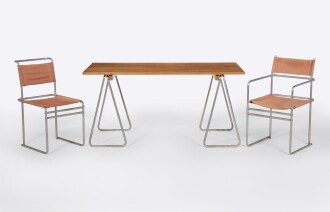Works by Marcel Breuer at Sotheby's
Marcel Breuer Biography
Though perhaps most well known for his metal tube furniture, Marcel Breuer was first and foremost an architect and a leading exponent of the International Style – a 20th century design mode that employed newly developed materials and fabricating processes to create largely minimalist architectural designs.
Breuer was born in 1902 in Pécs, Hungary. Propelled by his early interest in design, he enrolled at the famed Staatliches Bauhaus in 1920, and later became a teacher at the school. Under the direction of founder Walter Gropius, the Bauhaus espoused modernist principles based around the tenets of form and function as well as the embrace of industrialized fabrication processes. Inspired by these principles, Breuer created the Wassily chair; structured with metal tubing and leather straps, it ultimately became an icon of mid-century modern design.
After Breuer left the Bauhaus, he established his own architectural firm in Berlin in 1928. Later, in 1937, he relocated to Cambridge, Massachusetts, to teach architecture at Harvard University. The relocation led to a reunion with Gropius who was then also teaching at Harvard, and the two juggernauts of 20th century design opened a joint firm and collaborated on several projects between 1938 and 1941. The final year of his work with Gropius was the same year Breuer started his own independent architecture firm, which he later relocated to New York. In 1956, he established the eponymous Marcel Breuer and Associates, a firm that went on to complete numerous prestigious projects in both the United States and Europe, including the Met Breuer building (formerly the Whitney Museum of American Art), and the UNESCO Headquarters in Paris.
Breuer retired from practicing architecture in 1976, and died in 1981 at the age of 79. His legacy of modernist design and its influence both in the realm of architecture and furniture production is significant, and continues to exert considerable influence through today. Pieces designed by Breuer can be found in the permanent collections of such institutions as the Los Angeles County Museum of Art, the Metropolitan Museum of Art, New York and the Musée des Arts Décoratifs, Paris.












